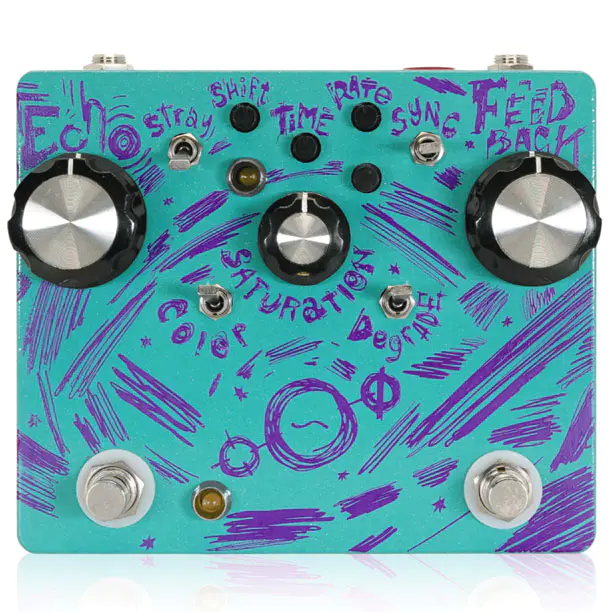
Pedal lovers with experimental leanings and tweaking urges will be happy to know about the Hungry Robot Aether, a new, PT2399-based modulated delay coming from a boutique builder with a great record of creative stompboxes full of knobs and switches.
And as a matter of fact, the Aether is one of the devices in the company’s roster with the highest number of controls, with a total of 3 knobs (three large ones and 3 tiny ones), 4 toggle switches, one push button, and two footswitches. we’ll seeon see what they do, after highlighting an important peculiarity of this pedal.
The most distinct feature of the Aether’s circuit is that the modulation is applied to the repeats’ time, rather than their pitch – although that does also affect the pitch, just like when you turn the time knob of an analog delay while it’s playing the repeats.
The “expected” controls here are most of the knobs, with the unmissable Echo (amount of delay), Feedback (number of repeats, leading to self-oscillation when all the way up) and Saturation knobs, plus the smaller ones controlling (delay) Time and (modulation) Rate, which has a both knob and a push button to set the modulation’s speed via tap tempo. The Sync toggle next to this section can deactivate the manual rate and synch it with the delay’s time (middle position) or set it at a rate that’s half the one of the delay time (down position). The up position activates the manual rate controls.
The Shift knob has a slightly confusing name but it’s basically the modulation’s depth, in this case equivalent to the shift of delay time causing the pitch shifting effect. Lower settings will produce a limited, cyclical pitch shift of the repeats that’s pleasing to the hear, while things will get rather “seasick-like” at higher settings.
The remaining three toggle switches add interesting variations to the effects:
- Color gives you warm analog (darker) and bright tape (darker) voicings on the repeats
- Degrade adds lo-fi textures and artifacts to the repeats, with the effect getting increasingly more pronounced at higher delay times.
- Stray changes the LFO from a Sine wave to a Slewed Random waveform.
The two footsweitches deal with on/off and delay tap tempo duties.
But sounds speak louder than words, so check out what this little gem can do in the video below.
Hungry Robot Aether, Builder’s Notes
The Aether is a modulating delay pedal.
The initial vision for the design of The Aether came shortly after the release of the Wardenclyffe Deluxe. I wanted to steal design philosophies and incorporate tonal characteristics that made the Wardenclyffe so special, but this time as a delay pedal.
At the heart of The Aether is a PT2399, tap tempo delay. It has the standard Echo, Feedback, and Time controls you would expect on any delay, but what makes it special is the Color, Saturation, and Degrade Controls. The Color toggle completely changes the character of the Aether and has two voices: Warm Analog and Bright Tape. The Saturation knob is a gain adjustment that overdrives the delay chip. In my opinion, the PT2399 chip takes gain and drive better than any other chip. The Degrade toggle adds lofi textures and artifacts to the delay line. The Degrade toggle removes a very vital section of the delay circuitry that keeps the delay stable with longer delay times. As you increase the delay time, the artifacts become more present and lofi.
The Aether uses a simple, but versatile modulation LFO core inspired by the Wardenclyffe, but with more features. The LFO cores sets it apart from other modulated delays out there. The speed of the modulation core can be set 3 different ways: Rate knob, tap tempo tact switch, and Sync toggle. When the Sync toggle is set to its middle position, the LFO can run at whatever speed you want. When the Sync toggle is in the up position it is synced to the delay time. When the Sync toggle is in the down position, it is synced to delay time, but in half-time for slower evolving moduation. The Shift knob determines the depth of the modulation and I promise that this has plenty of range in case you want to get really obscene. The Stray toggle changes the LFO from a typical Sine wave to a Slewed Random waveform. Creative exploration of the modulation section of The Aether is strongly encouraged. The way the delay rate and LFO rate interact with each other can yield very creative






















